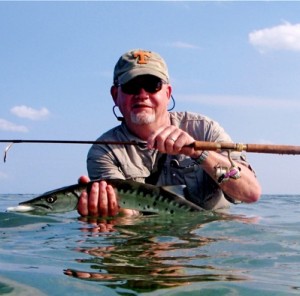 We interrupt the Mid-Atlantic’s snowiest winter on record with a tropical interlude in hopes it might at least warm a few spirits while we wait for spring. Dianne and I are just back from a week aboard the good ship Norwegian Dawn, cruising to Belize and Costa Maya, Mexico. Like any respectable redneck honeymoon, we took the kids, or at least one of the kids, or to be more precise, he took us. Daniel, who plays bass with the hot new rockgrass band Larkin Poe, was invited on this year’s Cayamo Cruise. Cayamo is the hillbilly equivalent of hawg heaven considering the number of talented roots music musicians involved. With artists like Lyle Lovett, Robert Earl Keen, Steve Earle, and Emmylou Harris on board, we jumped at the opportunity, especially since I had the not-so-secret ambition to jazz up our musical journey with some fishing. I decided to post a report in an attempt to illustrate our methods for finding fish in totally unfamiliar territory. Here’s our story:
We interrupt the Mid-Atlantic’s snowiest winter on record with a tropical interlude in hopes it might at least warm a few spirits while we wait for spring. Dianne and I are just back from a week aboard the good ship Norwegian Dawn, cruising to Belize and Costa Maya, Mexico. Like any respectable redneck honeymoon, we took the kids, or at least one of the kids, or to be more precise, he took us. Daniel, who plays bass with the hot new rockgrass band Larkin Poe, was invited on this year’s Cayamo Cruise. Cayamo is the hillbilly equivalent of hawg heaven considering the number of talented roots music musicians involved. With artists like Lyle Lovett, Robert Earl Keen, Steve Earle, and Emmylou Harris on board, we jumped at the opportunity, especially since I had the not-so-secret ambition to jazz up our musical journey with some fishing. I decided to post a report in an attempt to illustrate our methods for finding fish in totally unfamiliar territory. Here’s our story:
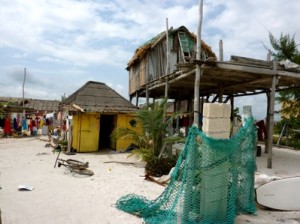 If you’ve followed my past reports you probably know that my sons and I find it extremely satisfying to go into an area we’ve
If you’ve followed my past reports you probably know that my sons and I find it extremely satisfying to go into an area we’ve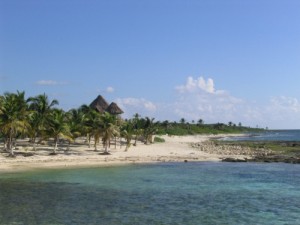 never been and apply basic light-tackle techniques to find our own fish. Since we only had two days off the ship, we decided to hike the Mayan ruins of Belize on day one and wait until we reached Costa Maya to do our fishing. The cruise line offers shore excursions for baitfishing or trolling around the outer reefs, but we found neither very appealing. The prospect of forking down a lot of cash to go out and reel in a fish from a stranger’s trolling spread didn’t sound like much of a challenge, especially since we’d packed our own gear. I brought enough tackle for two since Daniel was already on-tour when we caught up with him in Miami. I packed two travel rods, some ultra-light reels, and a small gear bag in which I’d thrown a few spinners and soft plastic baits along with pliers, extra line, swivels, and my waterproof camera.
never been and apply basic light-tackle techniques to find our own fish. Since we only had two days off the ship, we decided to hike the Mayan ruins of Belize on day one and wait until we reached Costa Maya to do our fishing. The cruise line offers shore excursions for baitfishing or trolling around the outer reefs, but we found neither very appealing. The prospect of forking down a lot of cash to go out and reel in a fish from a stranger’s trolling spread didn’t sound like much of a challenge, especially since we’d packed our own gear. I brought enough tackle for two since Daniel was already on-tour when we caught up with him in Miami. I packed two travel rods, some ultra-light reels, and a small gear bag in which I’d thrown a few spinners and soft plastic baits along with pliers, extra line, swivels, and my waterproof camera.
Just like fishing the Chesapeake watershed or an Appalachian stream, the first order of business in Mexico was to find access to good waters. Daniel speaks some Spanish, so once off the ship he started quizzing the local merchants and shopkeepers. After a half-dozen unsuccessful queries, we found a bartender who sounded like he knew a little about fishing. Over samples of ten-year-old anejo, we made a plan. I bargained for an all-terrain vehicle and we set off down the beach. Dianne accompanied us for the sightseeing and was gracious enough to photographically document our trip.
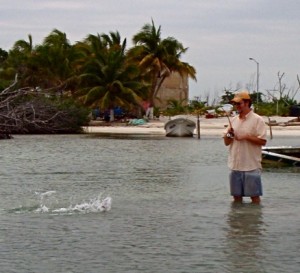 We didn’t have a clue what kind of fish we would find, much less what their feeding habits might be, so we looked for the two essential elements of any fishing situation: current and cover. We found both near a small concrete pier on the outskirts of a little fishing village called Mahahual. The pier caused a little rip in the current along the shore. There were a couple of half-sunken boats strewn about a knee-deep grass flat. We sat down in the shade of some banana trees beside a couple of disinterested iguanas and tied on our lures. I opted for a flashy spinner while Daniel threaded a six-inch bass assassin onto an offset 4/0 hook.
We didn’t have a clue what kind of fish we would find, much less what their feeding habits might be, so we looked for the two essential elements of any fishing situation: current and cover. We found both near a small concrete pier on the outskirts of a little fishing village called Mahahual. The pier caused a little rip in the current along the shore. There were a couple of half-sunken boats strewn about a knee-deep grass flat. We sat down in the shade of some banana trees beside a couple of disinterested iguanas and tied on our lures. I opted for a flashy spinner while Daniel threaded a six-inch bass assassin onto an offset 4/0 hook.
Daniel was first up, easing quietly into the water and stepping lightly to avoid stirring up the bottom. He made a long cast toward one of the wrecks and started twitching his lure along the surface. Suddenly, we noticed a lightning-fast wake approaching at an intercept angle from across the flat. SLAM! The fish had to be going 30 miles per hour when it attacked the bait. Daniel waited for the line to come tight then set the hook. Unfortunately, the fish threw the lure after only a few seconds. We looked at each other in disbelief at the ferocity of the strike. We’d hoped we’d find fish, but top-water action in crystal clear water was almost too good to be true. After a couple more casts, Daniel hooked up again. This time, after a quick but violent fight he landed a two-foot lon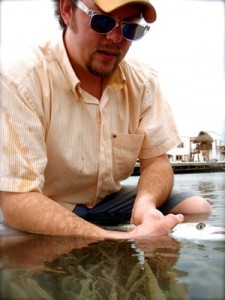 g barracuda.
g barracuda.
So that was to be it, we were barracuda fishing. I have no idea as to whether or not barracuda are a preferred species, or even if they’re considered challenging to catch. None of that mattered because we only had a short time to fish and we’d found explosive action on surface lures. We were happy. Now that we had narrowed down the general location, found the appropriate depth, and identified a productive lure, it was time to start fine-tuning so we could optimize our chances. We decided to break for lunch and regroup.
The first order of business was to change my line and switch over to the same rig Daniel had found successful. A couple of bite-offs told me my 4-pound test was too light, so I re-spooled with eight. Judging by the way some of the fish bolted toward our lures then came to an abrupt stop, I thought we needed as little terminal tackle as possible. A swivel was necessary because an un-weighted plastic bait fished on the surface is sure to twist monofilament. Since we thought the fish were seeing the swivels, we tied them up the line about twenty-four inches.
I was running low on hooks, but I found some of my homemade half-ounce jig heads in my bag and used my pliers to pinch off 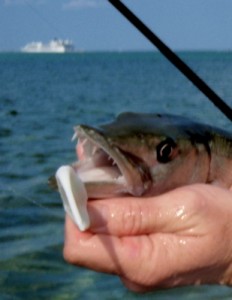 all the lead leaving just enough remaining on the shaft of the hook to fit inside the plastic bait. This homemade “flutter hook” would add a little weight but not too much. I could still work the lure on the surface with a quick retrieve, yet it would slowly sink into the grass when I paused. I also embedded the hook further down into the lure because the toothy fish would sometimes attack the tail of the bait and bite it off completely. I hoped this arrangement would result in more reaction strikes and fewer missed hook-ups.
all the lead leaving just enough remaining on the shaft of the hook to fit inside the plastic bait. This homemade “flutter hook” would add a little weight but not too much. I could still work the lure on the surface with a quick retrieve, yet it would slowly sink into the grass when I paused. I also embedded the hook further down into the lure because the toothy fish would sometimes attack the tail of the bait and bite it off completely. I hoped this arrangement would result in more reaction strikes and fewer missed hook-ups.
All that remained was to key-in on a more optimum fishing spot. We had noticed sandy pockets on the bottom of the grassy reef and found that we got more strikes when we targeted the edges of the deeper holes. We also realized that we got fewer strikes after we had fished the area for a while. Obviously, the fish were figuring us out. Having identified a pattern but needing new territory, we set off down the beach in hopes of finding even better bottom contour. Fortunately, it was easy to judge the bottom from the dirt road along the shore, so we didn’t have to look long. We pulled up in front of a rambling shack. Daniel made his way around their clothesline that was flapping with colorful shirts and negotiated with the property owners for permission to park. He even landed us a couple of cold beers in the process.
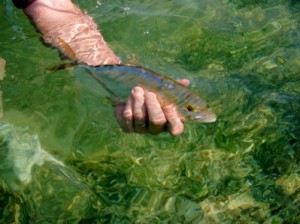 The action here was fast and furious. We were only in about ankle deep when Daniel hooked up. The long silver fish jumped completely out of the water after his lure. I followed with another nice barracuda in short order. Our strike to fish ratio had improved to about five to one. Not great, but good enough since we got multiple strikes on every cast. Once we waded out toward a steeper drop-off in the reef, we started seeing other kinds of fish and caught some strong-fighting jacks as well. We were hoping for bones but never saw any. Although none of our fish were really huge, some of the barracudas were approaching thirty-inches. They just about maxed out our ultra-light gear and w
The action here was fast and furious. We were only in about ankle deep when Daniel hooked up. The long silver fish jumped completely out of the water after his lure. I followed with another nice barracuda in short order. Our strike to fish ratio had improved to about five to one. Not great, but good enough since we got multiple strikes on every cast. Once we waded out toward a steeper drop-off in the reef, we started seeing other kinds of fish and caught some strong-fighting jacks as well. We were hoping for bones but never saw any. Although none of our fish were really huge, some of the barracudas were approaching thirty-inches. They just about maxed out our ultra-light gear and w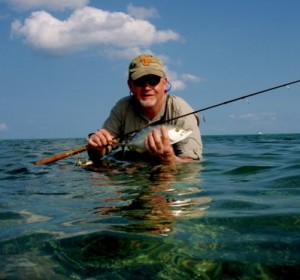 e enjoyed all the drag screaming we could handle.
e enjoyed all the drag screaming we could handle.
Daniel had to perform that night, so we reluctantly left the fish biting and headed back toward the ship. We had just enough time to celebrate our success with a little more anejo. Whether or not this is typical fishing in this part of Mexico I can’t say. I hope it is because I’d like to go back sometime. What I can say is that it was a lot of fun for little more than pocket change. Maybe next time we’ll hire a light tackle guide in the area and really learn the ropes, but we really couldn’t have asked for a better day. There’s a lot to be said for finding your own fish no matter where you’re fishing.




Nice to see you back in action, been wondering where you’ve been. I was just getting ready to send an email and thought I’d check CLT first. Looks like an outstanding vacation, congrats. Steve Earle…Copperhead Road…one of my all time favorites!
That was cool! Looks like you all had a blast! What a day!
Shawn,
That was a very enjoyable read! The barracuda sounded really exciting. I tied into one once in the keys that made a couple hundred foot run in a matter of seconds before I lost it. It looks like you were having some fun with some jacks as well. Shades of bluefish bite-offs off of Poplar in August! Thanks for sharing.
Don
Hey Shawn,
Awesome story, looks like you & your son had a blast. Pretty cool to see how those BKDs work on those ‘cudas. Did you figure out that they didn’t like the ‘spike? so you had to go without the garlic? 🙂
Thanks for sharing!
Tony
I’m so jeolous I can’t see staight. Glad you had a good time. Daniel’s band sound pretty good too.
Mike